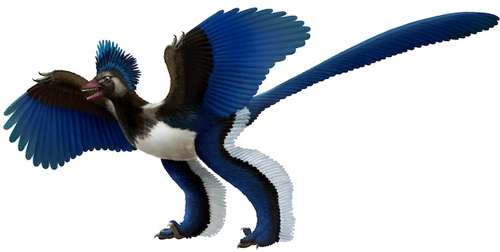
A highly publicized article appeared in Nature yesterday morning, describing the lovely creature so artistically reconstructed in the image above: Xiaotingia zhengi, an early bird-like dinosaur that might help answer these questions. The findings were very quickly picked up by The Guardian, Wired Science, Not Exactly Rocket Science, Pharyngula, Live Science and Nature News, of course, among other media outlets and blogs. Partly because the archetypical "original bird" Archaeopteryx is involved. Do head over to any of those pages first for pithy summaries of the findings.
Both major Swedish newspapers were content with copying the news telegram: "Original bird was not a bird". Also here.
The description of the Xiaotingia fossil and phylogenetic analyses comparing it to other bird-like dinosaurs and early birds seems to place it together with Archaeopteryx among a dinosaur group, the Deinonychosaura, and not at the base of bird evolution. So the Xiaotingia findings call into question where the line should be drawn between birds and dinosaurs, more so than having something specific to say about Archaeopteryx itself. As with most phylogenetic trees, many of the branches are missing in the evolutionary history of the dinosaur-bird transition. The really interesting thing to consider in the light of Xiaotingia and other bird-like dinosaur findings is how beautifully gradual the transition must have been, and how remarkably early bird-like traits appeared in dinosaur evolution, in what now appears to have been a diverse and successful group of organisms. As PZ Myers put it in his Pharyngula post:
There was a whole assortment of delicate-boned, feathered, bipedal dinosaurs that were flourishing and diversifying in that window of time, and we've now got enough data that we can distinguish details in the family tree, which is absolutely fabulous.
Xu, X., You, H., Du, K., & Han, F. (2011). An Archaeopteryx-like theropod from China and the origin of Avialae Nature, 475 (7357), 465-470 DOI: 10.1038/nature10288
No comments:
Post a Comment
Note: Only a member of this blog may post a comment.